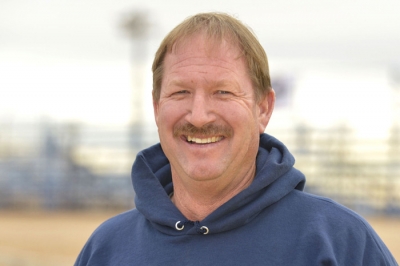
DirtonDirt.com exclusive
Retired California dirt racer facing grim future
By Todd Turner
DirtonDirt.com managing editorRacing three years ago at the track where he had previously enjoyed the best run of his career, John Lowrey steered to an impressive heat-race victory at Tucson (Ariz.) International Raceway during the Winter Extreme’s final weekend.
With standout Midwesterners Terry Phillips and Jimmy Mars among those who couldn’t keep up on that sunny January afternoon in 2013, Lowrey made the California contingent proud during the winter miniseries for Dirt Late Models, capturing Saturday's final heat race and pulling to the infield for a postrace interview. | Slideshow
It’s a paradoxical moment that Lowrey can’t remember — and can’t forget — a moment signaling the end of a racing career for the now 49-year-old oil field worker from Bakersfield, Calif.
Competing 11 months after sustaining a concussion during a Florida Speedweeks rollover accident at Volusia Speedway Park, Lowrey found himself in a troubling but increasingly familiar fog in the Tucson pits, unable to conjure what just happened on the racetrack after climbing from his red No. 8.
Long-time crewman Doug Robinson asked Lowrey about his comments during the DirtonDirt.com pay-per-view interview following the eight-lap heat, and Lowrey stared at his friend blankly.
“I said, ‘What’d you say?' ” the 48-year-old Robinson recalls. “I said, ‘Did you remember winning the heat race?’ He said, ’No.’ ”
Lowrey has heard the story enough times now to realize how crazy that must’ve sounded to Robinson and Chris Sivesind of Victory Circle Chassis, who also served on Lowrey’s crew.
“I was like, ‘What are you talking about? What interview? What are you even talking about?' ” Lowrey said.
Said Sivesind: “Right then, we started bringing up, ‘Something's not right here.’ ”
And Robinson knew Lowrey belonged anywhere but in a race car: “We said ‘That’s it, we’re loading up. We’re going home.’ ”
Within a month, Lowrey received the devastating prognosis from a concussion specialist that his brain cells were dying at twice the normal rate. Any vibrations to his head — for activities such as riding a bicycle, much less hammering the cushion in an 800-horsepower Late Model — would only increase the damage. And worse, the early onset of Alzheimer’s disease by age 55 was likely. Lowrey’s racing career was over.
Back at Tucson, Lowrey decided to go ahead and compete in Sunday’s final Winter Extreme program, knowing that the speed he craved would soon come to a screeching halt.
“I realized, ‘This is the last time I’m going to get to race.’ ” Lowrey recalled. “And I kind of pushed the pedal a little bit harder like, ‘I don’t want to get out of this car.’ ”
A love for racing
Born in Los Angeles in 1966, by the time he was in second grade John Lowrey’s family had moved 110 miles north to a growing Bakersfield, home of the famed “Bakersfield Sound” of country music star Buck Owens and the seat of sprawling Kern County, the richest oil-producing county in the United States.
It’s also the home of Bakersfield Speedway, where Lowrey's parents — his father, a truck driver who died of a brain tumor when John was 14, and his mother, in real estate management — took little John to the auto races not long after the family’s move. A paved racetrack in the 1970s, Bakersfield was a paradise for Lowrey, who couldn’t keep his eyes off the midget race cars wheeling around the third-mile oval.
“I saw them midgets coming off turn four, lifting the left-front wheel of the ground, and I was like, ‘I’ve gotta do that,’ ” Lowrey vividly recalls.
But it wasn’t until he was in high school that he returned regularly to the speedway, by this time a track with a dirt surface but still just as alluring. When he graduated and moved out on his own, he bought a 1974 Chevy Nova and fixed it up to go street stock racing. The power of the Nova’s V-8 engine was a little hard to handle for a teenager who drove a modest four-cylinder Chevy Luv pickup on the streets of Bakersfield.
“I was horrible,” Lowrey remembers, failing to sugarcoat his racing talents. “I wrecked every week.”
He got better over three seasons, but racing took a backseat to life a few years later as Lowrey continued in the oil-field business he originally started in high school with a job with Coastal Engineering.
“You’ve gotta realize,” Lowrey said, “we’re just oil-field workers.”
Other oil-field jobs came and went before Lowrey launched his own, one-man Premier Services in the mid-1990s, providing oil-service equipment for well operators, then, upon the urging of a customer, taking on leases of a handful of oil wells.
Settling into his career and in the second of two long-term relationships, the single Lowrey returned to the driver's seat at Bakersfield Speedway in the late 1990s, this time in the Late Model division. A novice in the full-fender class, wins were few for Lowrey for several seasons, but he posted regular top-five finishes in CarQuest Dirt Late Model Tour and Western Allstars events and contended in 2001’s Pacific Coast 100 at Bakersfield, a $5,000-to-win special won by Steve Drake.
Drake, Scott Pounds, Chad Reichenbach, Mike Johnson and hometown favorite Dick Shepherd were among the area’s best Late Model drivers during Lowrey’s early seasons, but Lowrey steadily improved, especially when Robinson and Sivesind joined him with local race car manufacturer Victory Circle Chassis stepping up its dirt program by 2005.
Lowrey jokes that Sivesind didn’t think much of Lowrey’s driving early on, but Sivesind saw progress.
“He was pretty out of control at the time,” the 45-year-old Sivesind says with a laugh. “He was very aggressive, and if the track ever slowed down, he wasn’t your guy at all for that condition … we worked for many years and got to where, at least on the West Coast, he was in the conversation among the guys who was in the hunt for a win all the time.”
The prime of Lowrey’s career was in the few seasons before his forced retirement, when he was serving as a de facto house car driver for Victory Circle as the Bakersfield chassis manufacturer branched into the other parts of the country, largely because of its connection with six-time World 100 winner Billy Moyer that began in 2007.
“We had good race cars. It made a big difference,” Lowrey said of the years with Victory Circle Chassis. “Before that, I didn’t have the best race cars and didn’t have the technical experience. Every once in a while, we’d run good in the early days, but it wasn’t consistent by any means.”
His connection with Moyer — whose friendship with Lowrey transcended racing as they later shared a vacation home near Lake Havasu, Ariz. — was enjoyable for Lowrey, who still crews for Moyer at occasional events.
"We would try a lot of (setup) stuff for him at home because we don't have anything that's important like he does,” Lowrey said. “That’s what we were trying. We were testing for him constantly. That was what we were supposed to be doing.”
In later seasons, “every time we went to the racetrack, we were testing something. Every once in a while you’d hit on something, and then other times, not so much,” Lowrey added.
Lowrey’s third-place points finish in the West Coast Late Model Shootout in 2010 and a $5,000 series victory at Santa Maria (Calif.) Speedway in 2012 proved Lowrey had made strides. Sivesind knew Lowrey had come a long way.
“That was the (best) feeling as a friend, was that Doug and I worked so hard … and there was a lot of chewing John’s ass,” Sivesind said. “There’s no doubt I’m hard-core and when I go to the racetrack and when I go to help you, I don’t go to run mid-pack. I hate mid-pack. Anybody that’s competitive, you don’t want to run second, you want to win. We worked hard to make John a better racer.”
It’s one reason why it’s been so difficult to see Lowrey's career come to a premature end.
“It was a great feeling for all of us,” Sivesind said. “And for that to happen … it just takes the wind out of everybody’s sail.”
Highs and lows
While Lowrey’s racing successes were mostly limited to Bakersfield and California tracks, he made a splash on the national scene at Tucson in 2012 during the competitive Wild West Shootout.
In a $3,000-to-win, 30-lap feature that included standout drivers like Moyer, Mars, Tim McCreadie, Shannon Babb and John Anderson, Lowrey took command from the outset, dominating the first dozen laps. But his car suddenly slowed, a faulty distributor forcing him into the infield and out of the race.
Moyer’s familiar No. 21 car went on to take the checkers, while Lowrey said he “wanted to cry” sitting in the infield, wondering what might’ve been.
“It was pretty much a heartbreaker, because I figured I could’ve won it,” Lowrey said. “Then you’re around people (in the pits) and they’re like, 'You had that won. They were never going to catch you.' ”
Moyer and Lowrey joked about the outcome after the race.
“My buddy 21 says there’s no way I was going to win, because he’d have wrecked me,” Lowrey says with a laugh. Moyer wanted to make sure “we weren’t going to be able to sit there when we’re 80 years old and I could talk about the one time I beat him … but I was going to put that trophy next to one of his (World 100) globe trophies, I’d already thought about that.”
It was that run, in part, that encouraged Lowrey a month later to make his debut at the rugged Florida Speedweeks, where a frightening, barrel-rolling accident on the frontstretch of the half-mile Volusia Speedway Park oval left Lowrey with a severe concussion.
“That's why I went to Florida because I thought, ‘Oh, I can lead races now; I can go to Florida.' … Maybe that was a bad idea to go to Florida,” Lowrey said.
Indeed, the competition at Speedweeks ramps up another couple of notches from Arizona, and Lowrey made a single feature lineup during seven nights of action between Bubba Raceway Park in Ocala and Volusia, which is in Barberville, just inland from Daytona Beach and NASCAR’s season-opening events.
Lowrey found trouble on the first Thursday night of action in Ocala, smashing the outside wall exiting turn four on the opening lap of his heat race. And his Speedweeks trip came to an end altogether the following Thursday when he got into the frontstretch wall again, triggering a consolation-race accident that sent him into a series of rollovers past the Volusia flagstand and nearly into turn one.
“On a restart I got on the outside fence. I don't know how I did it. I don't know if anybody touched me, or if I did it myself, and I started flipping down the front straightaway,” Lowrey recalls. “It was a pretty violent flip and hit my head on the bar five times. When I was flipping over I go, ‘Oh, this is going to hurt.' And it did.”
Crew members Robinson and Sivesind were watching the restart from outside the turn-one fence.
“Next thing I know it was just over and over and over and over again,” Robinson said, and amid the four rollovers the red car “landed on the driver’s side. Every time it landed. I knew (Lowrey) was hurt, because he’s got this little duck walk he does when he got hurt. And I’d seen that duck walk at Manzanita one time. I told Chris Sivesind, 'He’s hurt.’"
Lowrey climbed into the track ambulance while two wreckers were required to remove the car from the track, returning the mangled mess to Lowrey’s pit stall where Robinson and Sivesind struggled to load it up in preparation for the 43-hour haul back to California.
Refusing a trip to the hospital, Lowrey was discharged by medical personnel, and he walked through the pits in a fog, trying to remember where the team was pitted.
“I remember John came staggering up,” Sivesind recalls,” and I guess the ambulance had just dropped him off in turn two, and he came staggering up around (the pits), and he’s like, 'Anything I can do to help you guys?' We said, ‘You’ve done enough.’ ”
At that point, his crew hadn't “realized the magnitude of what really happened” with the concussion from Lowrey’s helmet repeatedly hitting the rollbars, Sivesind said, but something was clearly amiss.
Lowrey initially tried to drive the team’s hauler back to the hotel, but Robinson quickly realized he was in no shape to be behind the wheel. Robinson twice had to grab the steering wheel from the passenger seat on Florida State Road 40 before they stopped and Robinson climbed in the driver’s seat.
And while Lowrey climbed back into a race car later in 2012 after getting a new Victory Circle Chassis, he’d never be the same.
“Looking back, I can’t tell you what happened,” Robinson said. “At the beginning, we didn’t understand it … he wasn’t telling us there was anything wrong. It wasn’t until Tucson that next January that we understood it.”
Trying to bounce back
When Lowrey returned home from Florida, he visited his physician, who confirmed he’d sustained a concussion in the wreck at Volusia. And while Lowrey figured it was the 20th concussion of his life — he’d had several as a boy, then another half-dozen while racing — the doctor assured him he’d be fine soon.
But Lowrey never felt quite the same, especially in the moments after he climbing out of of his high-speed Late Model.
“I really slowed down in the work world, and just figured I'd get better,” Lowrey said. “I’ve had lots of concussions over my lifetime and after a while they go away, but this one just never went away. I slowed down in the work world and just took it easy.”
He was able to maintain a limited racing schedule in 2012, even notching his career-richest $5,000 payday at Santa Maria’s Nationals event on Memorial Day weekend, along with a couple of other victories that summer.
But occasionally when he climbed out of the car, he was unable to remember enough about the previous laps to tell Robinson and Sivesind what changes needed to be made to the car’s suspension.
Lowrey remembers he would get "just all goofy, blurry-eyed, like you had a bucket on your head, didn't even know what was going on. The crew was mad, but I couldn't tell them anything about the race car because I was just sitting there. Just kind of blah.”
Robinson and Sivesind detected slight changes in Lowrey, but it was never dramatic enough to spark a serious discussion about John’s health or the aftereffects of the Volusia accident earlier that season.
“He would ask questions over and over again, and getting feedback from the race car, I don’t think he could really remember what just happened on the racetrack,” Sivesind said. “After a while, he could remember it better, but at the moment (after he got out of the car), he couldn’t remember what happened. We didn’t know why that was. Absolutely, we just didn’t understand …
“You could just tell that he wasn’t the same guy, but we really didn’t understand why. We thought, 'Well, is it just because maybe he’s scared? Not scared, (but) just a little intimidated by what happened (at Volusia)?’ Because he wouldn’t drive as hard as he did before, the aggressiveness wasn’t there as much as it was before that.
“And just trying to figure out (the car), trying to get feedback from him was hard to get. But I didn’t understand why … we basically had to do (suspension changes) from what we saw and what we felt, Doug and myself.”
Robinson saw signs of Lowrey’s short-term memory problems, too. “He could sit and tell me stuff we did 15 years ago, but he couldn’t tell me what he did yesterday,” he said.
Hints of Lowrey’s problems became clear in January 2013 when the team returned to Tucson for the six-race Winter Extreme miniseries. Racing sporadically the rest of 2012 didn’t reveal the enormity of Lowrey’s issues, but practicing or competing seven times in a 10-day stretch crystallized it.
“We only raced once every couple of weeks, so I wasn’t ever in the car for a number of days in the row to make me feel goofy,” Lowrey said. But during the stretch of Tucson racing, “I didn’t know where I was at, or anything. Just kind of in La La Land.”
When Lowrey won the heat race in the second-to-last Tucson event — and couldn’t remember it moments later — it was obvious he needed help.
“That's when we realized I better stay out of a race car. I better go to the doctor and see what's happening,” Lowrey said.
Even when he wasn’t racing, Lowrey could tell things weren’t normal.
“You could kind of tell that something ain’t right … you don’t feel good, you’re not sharp mentally. Kind of foggy,” he said. “Kind of like hungover all the time, that’s how I felt a lot. And I’m not a drinker.”
Instead of returning to his physician, he traveled to the Amen Clinic in Newport Beach, Calif., to a specialist who had treated football players suffering from post-concussive symptoms. Checking in on Valentine’s Day in 2013, Lowrey went through extensive batteries of tests over two days.
Lowrey’s decision to seek a specialist was based in part on his concussions, and in part because he remembered his father slowly dying of a brain tumor in the late 1970s. He wondered if something similar could be happening to him.
Technicians studied images and scans of Lowrey’s brains while he performed repeated memory tests. At the conclusion of the testing, no tumor was found, but there were clear signs of concussive damage.
“He told me, ‘Your brain is dying twice as fast as you should, for someone your age,’ ” Lowrey said.
The doctor estimated Lowrey could have Alzheimer’s within eight years and recommended he avoid anything that caused his head to vibrate — race cars, obviously, but also bicycles, four-wheelers and motorcycles. The specialist even suggested avoiding high mountain altitudes and its thin air.
“It freaked me out,” Lowrey said. “When a guy says that … wait a minute, that can’t be right. 'I hope you have an office job,’ he said. ‘Yeah, I’ve got an office job,’ ” Lowrey quipped.
The circuitous trip from Orange County north to Bakersfield took five hours amid the heavy Southern California traffic, and Lowrey had plenty of time to consider his gloomy prognosis.
“It was pretty tough, yeah. It was pretty tough,” he said. "Driving home from L.A. in Friday afternoon rush-hour traffic, yeah that was pretty tough. You don't want to move your head, you don't want to ride a bike, I can't run, I can't ride a bike, I can't ride a four-wheeler, nothing to move your head, and when you're a speed freak like all of us, you know … everything you've done.”
“It's tough. It's kind of changes my whole perspective in life.”
The safety factor
When safety specialist Randy LaJoie heard John Lowrey’s story, it was all too familiar for the 54-year-old former NASCAR driver who won Busch Series championships in 1996-’97.
“Speaking from experience, I’ve had my share (of concussions) and if I hit my head one more time, I could hide my own Easter eggs,” LaJoie said. “And that’s one of the reasons I got out of the seat in ’06. My head wasn’t correct.”
LaJoie, who now owns and operates the Joie of Seating racing equipment, remembers one accident at Charlotte (N.C.) Motor Speedway where he was checked out by doctors on site, but he was so addled that he returned to the infield care center a second time, forgetting he’d been there in the first place.
Post-concussive syndrome among NFL football players has made headlines in recent years, and LaJoie knows some racers who’ve suffered repeated accidents could find themselves facing a similar fate.
“The containment seats have done a wonderful job from their chin down to their ribs (but) a lot of guys have been slow to get something around their head,” in part because of the limited space in race car cockpits needed to allow egress, said LaJoie, who has held safety clinics at more than 100 racetracks.
“In reality, the head is the most important part and it should be controlled the most,” he said. “(A safety) system has to be in play to control movement or lack of movement with the driver, and your head is an integral part of that. … that’s what we’re seeing in a lot of dirt applications, when (cars) get to flipping. You head is moving too far and you’re getting concussed from that.”
Lowrey realizes now he wasn’t always particular enough about his safety equipment, and when he goes to the racetrack now, he’s hyper-aware of drivers who cut corners.
“If I would have had the seats up to date, like everybody had, and everybody basically mandates, I wouldn't have got hurt as bad,” Lowrey said. “That’s all on me that I didn't have the best I could have had.
“I tried to do some stuff around home there to educate people that I've been educated on now. Don't be like me and be a dodo and not get the best seats you can get. Guys spend all their money on a race car and a $100 set of seat belts, and a $100 seat and go out there, and have the potential to get hurt for nothing.
“If somebody that's 20 years old this would have happened to ... If you could help somebody that doesn't do that then it is what it is. You've got to help somebody. That would be tough to handle if you didn't tell somebody what you learned.”
Robinson has heard Lowrey’s preaching to “spend more money on safety, or you’re going to end up like me if you don’t,” he said. “John’s really the kind of guy that likes to give back … he likes to joke and have a good time, but when he’s talking serious, you better take note. In the position he’s in, at the end of the day, it’s not fun.”
Sivesind himself was in a 1994 racing accident that involved a serious fire when a competitor’s fuel cell fell out of the car, and it “almost ended up costing me my hands” because of the severe burns.
“I see some of these guys around here not wearing gloves and it just infuriates me, because (Sivesind) has tore up hands,” Lowrey said. “If you've ever seen him, you'd see what I'm talking about. It's sickening over a pair of gloves guys say they can't feel the steering wheel, or this or that. Well, my friend Chris couldn't feel nothing for two years.
“The safety side has got to me a little bit and I've tried to help other people learn what I've learned. I guess that's the positive that's come out of this for me, it's to help other guys.”
An uncertain future
With the oil-well business worse than Lowrey’s ever seen it — “You just turn 'em off because you’re losing money every month” — not having to tend to wells or provide services for customers would allow him plenty of time to devote to racing.
But Lowrey has mixed feelings about being at the track these days. Last season, he tried to drive a two-seat Late Model for a charity fund-raiser, but he learned that getting behind the wheel even casually didn’t work.
“I want to get in a car every day, but I know that I can’t …. I (ran) the two-seater. I had that charity car (at Bakersfield). I did that one time last year in the middle of the summer and it made me sick. Literally, physically sick, so that's that. No more.”
Lowrey, whose tousled light brown hair and mustache resemble Nicolas Cage’s character from Raising Arizona (minus the sideburns), returned to Tucson in January to lend his buddy Billy Moyer a hand in the pits at the Wild West Shootout, but it’s difficult to be so close to something he once loved so much.
“I've been telling myself that there's a lot of people in this world that don't go around race cars, that don't have race cars, and they're pretty happy,” Lowrey deadpanned. “I’ve been trying that, and I don't know what they're happy doing, because I haven't found it yet.
“I'm pretty happy at the racetrack. To a degree because I know I can't climb in it. They were testing (in Tucson) and I'm thinking, 'Man, I should just get in that car out and drive around a couple laps, because I'd be happy if I just drove around a couple laps.'
“If I was in a race car every day I'd be happy. I don't hunt, I don't fish, so I'm still looking. I'm still looking for that thing that makes the rest of the world happy.
“I go to the races in Bakersfield a little bit just to see kids that I know, that I care about. I haven't been to a real race since (Tucson) last year. I didn't go help (Moyer) at all last year because I just don't want to go. Try to stay away and find something new, but I haven't found it yet.”
Sivesind, who dearly misses racing with Lowrey, knows it’s a challenge for Lowrey.
“I think it kills him now to go to the racetrack and not be able to race, because racing is such an adrenaline rush and addiction,” Sivesind said. “His head just hurt so bad after (trying to return) … we all take chances when we get in race cars, but the chances of him getting hurt again … you don’t want to take that chance in life.
“John and I are still friends … he shows up at the racetrack and watches the races, and you can see the want in him to get back out there and do it. I can’t imagine what that would be like.”
Lowrey’s absence is felt at Victory Circle Chassis, too, Sivesind says.
“It’s kind of a shame, because basically, John, he did a lot for us here at Victory Circle, being that the car was local. He’d let me do whatever I wanted on that race car, and basically he was my tech dummy … there was a lot of things I could relate to (with) what I did with John (that could help) with the average racer.
“John could help us make our program better, and I think it made our program better working with John,” Sivesind said. “With John gone, it’s hurt our program to a point.
“I just wish, as we all do, that we could’ve continued to race and have fun,” Sivesind continued. “It was fun … and I haven’t had fun racing, racing’s not fun like it used to be when we went racing with John. He’s just a good dude and he’s a lot of fun to be around. He just makes it fun. And I haven’t found anybody that I enjoy racing with that was that much fun.”
Robinson, who also works in the oil fields and rents a building from Lowrey for his welding supply company, knows Lowrey misses the racing.
“I think it’s worse now, because he has no outlet … you can drive a street car fast, but it’s not like driving a Late Model,” Robinson said. “I think more than anything now, he worries about the Alzheimer’s. … Kind of like, we’re not as invincible as we used to be. We’re getting close to 50 now. We’re not 25 anymore.
“We had talks about what’s going to happen in another four or five years … what’s going to happen when we’re 60. His deal is, he says he’s not going to make it to 60. I told him the other day, ‘We never thought we’d make it past 30, and here we are at 50.’ ”
Lowrey hasn’t returned to the specialist — “I don’t want to know any more” — and he hasn’t taken prescribed medicine that only made him sick.
When Lowrey thinks about the future, his first thought is that he doesn’t want to burden anyone. He never married, but he maintains a father-son relationship with 25-year-old Matt Bicknell, the son of former girlfriend Tonua, who had a 14-year relationship with Lowrey.
(Lowrey calls Bicknell, who he helped raise from a 5-year-old, his son. Bicknell has one child and his wife is expecting. “Matthew is part of the family,” Robinson said. “Just because he’s not blood doesn’t mean he’s not part of the family.”)
“I was 47 when that happened, and you always think you're going to live forever anyways,” Lowrey said. “The business opportunities, and what I've got planned for the end of my life, and what I'm going to leave my kid, what a legacy I'm going to leave him and my grandkids, that kind of stuff, and what you leave them financially.
“All of that changes. I'm single, so that changes your outlook on having a long-term relationship with someone if they are really going to want to take care of a mid-50-year-old guy. It just changes everything.
“It changes everything to hear that. You see people that are older, 70s or 80s, that have Alzheimer’s, and it's ugly. They've got to be taken care of 24 hours a day. Hell, I don't want someone having to take care of me like that. That's no quality of life. It's just like guys having cancer. It's the same thing, they know you ain't got a lot of time in life.
"That's just different. I always thought I'd live forever and be fine. You never know that you're going to climb in a race car and get hurt.”
Other than his failure to use better safety equipment, Lowrey doesn’t question his decision to become a race car driver.
“I don’t have regrets as far as ever climbing into a race car, because that’s been the fun stuff in life,” he said. “You better do what you want to do. There are no do-overs.”
And he doesn’t sit around and ask himself what would’ve happened if he’d never have gone to Florida. “You just do what you think is right at the time and go for it,” he said.
“My theory is I’ve lived a good life and I know where I’m going to go when I die, but at some point, it did hit me, not so long ago. You want to keep denying it, you’re going to live forever. ‘I can live through anything. I can make it. I can do anything and nothing’s going to keep me down.’ ”
Facing the future isn’t easy, he said.
“It’s not about you. It’s about the people you care about. You’re not going to be able to be with them,” said Lowrey, who recently visited with a friend who’s battling leukemia. “‘I’m not afraid to die. I’m afraid of not living,’ ” the friend told him. “And that’s kind of how I’ve been,” Lowrey said.
“As time gets longer, I think that changes. I’m definitely not looking forward to having someone take care of me. I don’t want to have to go to a damn nursing home and have somebody shower me … that’s not quality of life. Quality of life is the key. Not just life."

















































